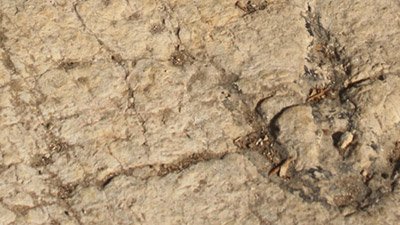Dinosaur Footprints
Dinosaur Footprints
Dinosaur footprints create an apparent dilemma for creationists. How could they ever be made and fossilized during the Flood? Conventional geologists also face a dilemma. If geologic change takes place slowly, surely footprints made in mud would be obliterated by wind and rain.
Dinosaur Tracks
Millions of dinosaur tracks have been discovered in sedimentary rocks all over the world. At first glance, it seems difficult to explain the formation of dinosaur tracks during the Flood. A closer inspection of the details, however, demonstrates that the Flood is a reasonable explanation.
Dinosaur Stampede
Lark Quarry in Queensland is home to the only known fossil record of a dinosaur stampede. There, preserved in mid-Cretaceous rock, are about 3,300 individual tracks representing about 150 dinosaurs of varying sizes and kinds.
News About Dinosaur Footprints
-
Sept. 3, 2024 from Ken Ham Blog
A new find makes one fossil trackway even more incredible because the trackway is split between two continents and separated by the Atlantic Ocean.
-
Sept. 11, 2023 from Ken Ham Blog
How can footprints be preserved? That’s a question we should be asking after a recent discovery in Texas, made possible by low water levels.
Articles About Dinosaur Footprints
-
Jan. 27, 2016 from Answers in Depth
The only positive evidence supporting the assertion that these dinosaurs were dancing for mates is that some modern birds engage in ritual courtship dances.
-
In-Depth ArticleBird X-Rays Shed Light on Dinosaur TracksDec. 12, 2014 from Answers in Depth
Can walking birds trace tracks back through the sands of time and correct some false impressions of dinosaurs?
-
In-Depth ArticleDo Duck-Billed Dinosaur Tracks Trace Hadrosaur Habits?July 26, 2014 from Answers in Depth
A storybook version of hadrosaur history collapses, favoring an interpretation based in eyewitness history and the observable data.
-
In-Depth ArticleAlaskan Dinosaur Tracks Buried in the Global FloodOct. 10, 2013 from Answers in Depth
Fossils like thousands of “blobs with toes” mark the presence of dinosaur diversity in the Alaskan past.
-
Magazine Department ArticleTracking Dinosaurs Down UnderOct. 1, 2013 from Answers Magazine
Fossilized dinosaur tracks attest to the reality of God’s judgment in Noah’s Flood, which is no fiction but an actual historical event.
-
Research PaperDinosaur Stampede Version 2.0May 23, 2013 from News to Know
Preserved in Lark Quarry’s mid-Cretaceous rock are almost 4,000 individual tracks representing about 180 dinosaurs.
-
Paluxy River Tracks in Texas SpotlightApril 14, 2012 from News to Know
Paluxy River tracks in the Texas spotlight
-
Book ChapterDinosaur FreewayFeb. 4, 2012 from News to Know
Is the Dinosaur Freeway a record of migration “to find new forage” or a panicky attempt to evacuate?
-
Discovering the Cause of Giant Dinosaur StampedeDec. 3, 2011 from News to Know
The great dinosaur stampede mystery solved (again).
-
Matching Footprint Found Under ProtoceratopsSept. 17, 2011 from News to Know
Skeleton in the closet puts its foot down.
-
Fossilized Footprints and History of DinosaursOct. 9, 2010 from News to Know
Evolutionists claim that fossilized footprints found in Poland give clues as to the history of dinosaurs.
-
Oct. 1, 2010 from Answers Magazine
Dinosaur footprints create an apparent dilemma for creationists. How could they ever be made and fossilized during the Flood?
-
Dancing Dinosaur Footprints BustedNov. 15, 2008
Remember the “dinosaur dance party” we reported on News to Note three weeks ago? Yeah, forget that.
-
Dancing Dinosaur Footprints Found In ArizonaOct. 25, 2008
Out come the dinosaurs and down comes the disco ball—a lively social scene from 190 million years ago?
-
Yemen Fossils Discovered to Be Dinosaur TracksJuly 26, 2008
The locals in the village of Madar, Yemen, are finally learning that the fossilized footprints running around their town weren’t made by giant camels!
-
Semi-Technical Research PaperDinosaur Footprints, Fish Traces and the FloodApril 1, 2003, pp. 54–59
Recently Woodmorappe drew attention to recent work reinterpreting certain alleged dinosaur tracks. However, he adds several comments that appear to some to be unwarranted and open to challenge.
-
Magazine ArticleIn the Footsteps of GiantsMarch 1, 2003, pp. 10–12
It seems difficult to explain the formation of dinosaur tracks during the Flood. A closer inspection of the details, however, demonstrates that the Flood is a more reasonable explanation.
-
Dinosaur Pursuit?April 2, 1998
Fossils are not only bones, but any remains of dead organisms, including tracks.
-
Magazine ArticleHuman and Dinosaur Footprints in Turkmenistan?Sept. 1, 1996, pp. 52–53
Human footprints lie alongside thousands of dinosaur prints on a Turkmenian plateau, a Russian newspaper has reported.
Recommended Resources

Answers in Genesis is an apologetics ministry, dedicated to helping Christians defend their faith and proclaim the good news of Jesus Christ.
- Customer Service 800.778.3390
- © 2024 Answers in Genesis





